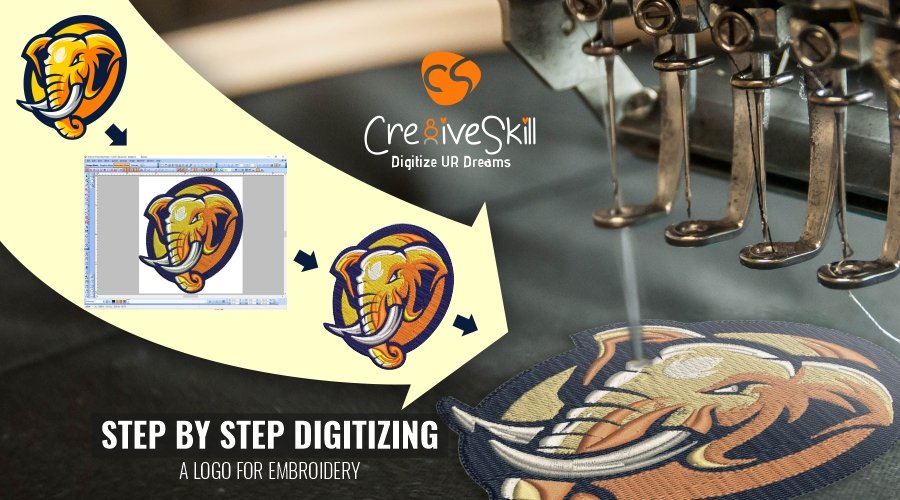Efficient Digitizing for Embroidery: Quick Turnaround
Efficient Digitizing for Embroidery: Quick Turnaround
Blog Article
Simplifying the Art of Embroidery Digitizing: Step-by-Step Overview
As technology proceeds to breakthrough, the digitization process has actually become a lot more easily accessible, enabling lovers to bring their elaborate styles to life with convenience. In this guide, we will untangle the complexities of needlework digitizing, breaking down each action carefully to streamline the process and empower both novices and skilled embroiderers alike.
Understanding Needlework Digitizing Software Program
Embroidery digitizing software program serves as an important tool for transforming elaborate layouts right into electronic layouts suitable with needlework equipments, promoting precise sewing and modification. This specific software program enables customers to import numerous picture documents formats, such as JPG or PNG, and convert them right into embroidery machine-readable formats like DST, EXP, or PES - Digitizing for Embroidery. By utilizing functions like stitch editing and enhancing, rug options, and string color option, digitizing software program makes it possible for customers to control every aspect of the layout process
Furthermore, progressed embroidery digitizing software uses tools for creating intricate styles, changing stitch thickness, and including complex information. Individuals can also sneak peek the layout prior to sewing it out, guaranteeing precision and decreasing errors. Additionally, several software application programs give automatic features that aid simplify the digitizing process, conserving time and effort.
Recognizing the capacities of embroidery digitizing software application is important for attaining top notch lead to needlework jobs. By understanding this tool, embroidery enthusiasts and specialists can release their creative thinking and bring elaborate styles to life with accuracy and efficiency.

Choosing the Right Style Data
After familiarizing yourself with the abilities of needlework digitizing software program, the following vital action in the procedure is choosing the best design declare your task. Digitizing for Embroidery. When selecting a design apply for embroidery digitizing, it's vital to think about the complexity of the style, the dimension of the final item, and the kind of textile you will be collaborating with
For elaborate layouts with fine information, a high-resolution image or vector documents is recommended to guarantee that the embroidery device can properly reproduce the style. Furthermore, the dimension of the last product plays a significant duty in picking the best design documents. Bigger designs might require greater resolution files to maintain clearness and intensity.
Additionally, the kind of textile you will be embroidering on affects the choice of style data. Different materials might require adjustments in the layout file to guarantee that the stitches are correctly straightened and the layout looks like intended. By very carefully picking the ideal layout data based upon these variables, you can set on your own up for a successful needlework digitizing procedure.
Digitizing Devices and Techniques
Making use of specialized software application and precision strategies, digitizing tools are crucial in transforming complex designs right into embroidery-ready documents. Embroidery digitizing software, such as Wilcom, Hatch, or Embrilliance, supplies the essential platform to transform art work into stitch information. These programs supply functions like stitch editing and enhancing, padding options, and text tools to ensure the style converts seamlessly onto fabric.
Among the vital techniques in digitizing is developing a clear path for the embroidery machine to comply with. This includes digitizing each element of the style with precision, figuring out stitch types, densities, and directions. By utilizing devices like digitizing tablets or software-specific plugins, embroiderers can accomplish a high level of This Site accuracy in their digitized layouts.
Moreover, grasping the art of padding stitching is critical for producing quality embroidery. Underlay stitching maintains the fabric and creates a foundation for the layout, making certain that the final item is both aesthetically appealing and resilient. By comprehending these digitizing tools and techniques, embroiderers can elevate their craft and bring intricate designs to life with precision and efficiency.
Customizing Stitch Kinds and Instructions
The selection of stitch kinds can considerably affect the general look and try this texture of the stitched style. By strategically integrating these stitch types, embroiderers can achieve deepness and measurement in their layouts.
In addition, the direction of stitches plays a vital function in boosting the visual appeal of the final embroidery. Diverse stitch directions can include appearance, emphasize details elements, and develop aesthetic interest. For example, altering the angle of stitches can simulate motion or natural patterns like hair or feathers. By trying out various stitch angles and patterns, embroiderers can bring their layouts to life with remarkable information and intricacy. Grasping the art of personalizing stitch kinds and instructions equips embroiderers to unleash their creativity and elevate the top quality of their work.
Testing and Refining Your Digitized Layout
To make sure the accuracy and top quality of your digitized style, complete screening and refinement are vital actions in the embroidery digitizing process. As soon as you have completed the digitization of your design, it is critical to evaluate it before continuing with the actual needlework. Evaluating permits you to recognize any potential issues such as thread breaks, sew density issues, or layout distortions that might impact the last outcome.

After testing, it is essential to refine your digitized style based on the feedback from the examination sew-out. This may include tweaking stitch settings, changing densities, or making changes to the overall style to achieve the desired outcome. By iterating via screening and improvement, you can fine-tune your digitized design to perfection prior to moving on with the real needlework process.
Conclusion
Finally, grasping the art of embroidery digitizing requires a complete understanding of the software program, choosing the best style data, using digitizing tools and techniques, personalizing stitch kinds and directions, and testing and refining the digitized design. By complying with these actions, embroiderers can simplify the digitizing procedure and create top notch embroidered designs with accuracy and effectiveness.
Report this page